THE TESLA FRAME
Published in the “Art Business Today”, August 2014
a Fine Art Trade Guild publication, London, UK
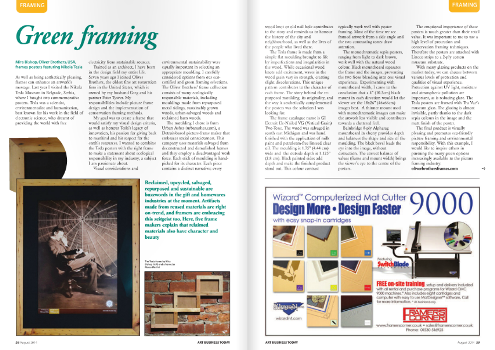
“let the future tell the truth, and evaluate each one
according to his work and accomplishments.
The present is theirs; the future, for which I have really worked, is mine.” –
Nikola Tesla
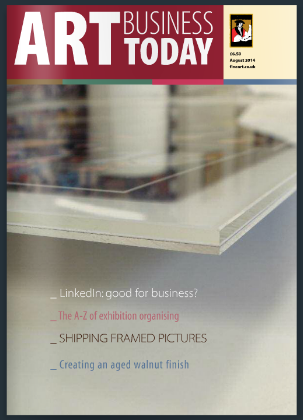
Picture frames can make a powerful statement. While creating an aesthetically pleasing finished product, a frame also has the ability to enhance an artwork’s message. Furthermore, with the right design, the connection between the two can result in a new development of ideas.
An Inspiration
This past summer I had the pleasure of visiting Nikola Tesla’s museum in Belgrade, Serbia. The museum is situated in a charming old building located in the heart of downtown. The official tour consists of live experiments as well as an explanation of Tesla’s personal artifacts. In addition, the museum houses his physical remains in a gilded sphere urn.
On this summer day, the museum was packed with visitors from around the world who came to learn more about this fascinating man. I truly felt honored to be there and pay respects to this great Serbian – American, the “the Man That Invented the 20th Century.”[i] While at the museum, I purchased two commemorative posters; however, it wasn’t until I came home to the United States that I started thinking about a meaningful way to frame them.
Who was Nikola Tesla?
Nikola Tesla was a Serbian-American inventor and engineer. He is best known for his contributions in the advancement of electrical sciences. Tesla left our world with countless discoveries, developments and inventions that power our everyday lives to this day. According to Dr. Michael Pravica, a physicist at UNLV, Tesla “is largely regarded as one of the greatest minds of all time” and “was far ahead of his time as many of his visions are only now being realized.”[ii]
Tesla firmly believed in providing the world with free electricity without depleting our natural resources. Known as a “father of radio,” he became renowned for his innovations including: alternating current, x-rays, remote control, the electric motor, robotics, lasers, electronic ignition for gas engines, and wireless communication to name a few. In addition to his myriad inventions and over 700 registered patents, Nikola Tesla was never content with merely pushing the frontiers of scientific advancement. Above all else, he was determined to use his research as a means to help both the world and the human race as a whole.
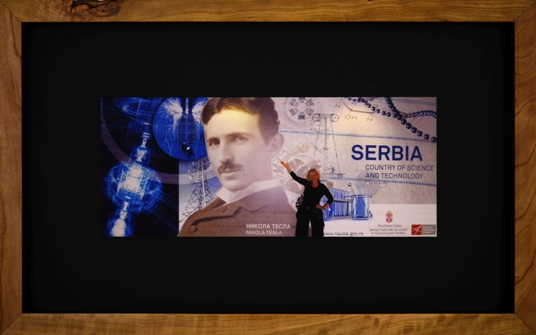
Mira Bishop at the Nikola Tesla Airport, Belgrade, Serbia, August 2013
He was also an environmentalist. According to Jane Alcorn, President of the Tesla Science Center at Wardenclyffe, Tesla was “very concerned about the fact that we were using up the Earth’s resources too quickly, and he wanted to make sure that we were using non-fossil, renewable fuels.”[iii] His selfless nature, passion, and true love for progress, both on a human and scientific level, were unquestionably one of his most remarkable aspects.
Selecting the Frame
Oliver Brothers is known for restoring and conserving fine art for the past one-hundred-and-sixty years and its excellence in museum quality custom framing. As a result, we deal with unusual and special projects on an almost daily basis. As the head of custom framing, I always strive to create a cohesive union between the artwork and the frame, a union that also leads to a new message, a new idea. This time I had the perfect opportunity to combine an artwork with the right frame to make a statement about ecological responsibility in my industry – a subject I am passionate about. This was a great pleasure and a unique opportunity.
Both the visual effect and environmental sustainability were equally important in selecting an appropriate frame moulding. Out of the many choices on hand, I carefully considered options from our eco-certified or green framing selections. The Oliver Brothers’ frame collection consists of many ecologically responsible materials including repurposed metal siding frames, sustainably grown woods, as well as urban-salvaged woods, and reclaimed barn woods.
I selected a frame that is visually striking and also directly compliments my own vision towards respecting and re-using our natural resources. As many industries are changing and evolving in a positive direction, I wanted to use my contribution as an example of how the custom picture framing industry is changing as well.
Urban Ashes is a Detroit-based picture-frame maker that embraces the social consciousness. This company uses materials salvaged from deconstructed and demolished homes. They also employ and aid a disadvantaged work force. Each stick of moulding is handpicked for its character. Each piece contains a distinct narrative; every wood knot or old nail hole contributes to the story and reminds us to honor the history of the city and neighborhood as well as the lives of the people who lived there.
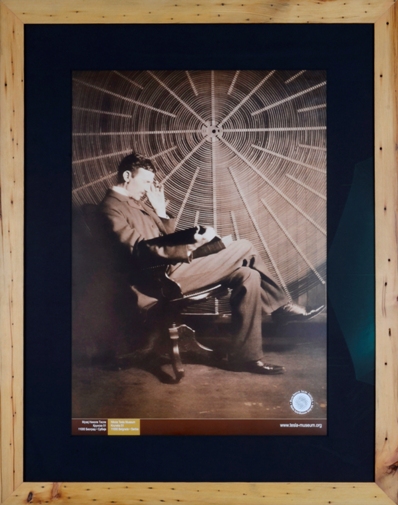
Nikola Tesla in front of the spiral coil
of his high-frequency transformer
at East Houston Street laboratory, New York, 1896
The Frame
The Tesla Frame is a simple flat moulding brought to life by imperfections and irregularities in the wood. While occasional wood knots add excitement, waves in the wood grain vary in strength, creating slight discolorations. This unique pattern contributes to the character of each frame. Both frames were unique with their own individual beauty. The story behind the re-purposed moulding, its originality, and the way it aesthetically complemented the posters was the solution I was looking for all along.
By combining the frames made by Urban Ashes with the images of Nikola Tesla, I celebrated and embraced the positive influence of Tesla’s work on our society ‘as well as the values shared by him, the company and myself. This newly created message enhances the viewer’s experience of the piece. The frame and the subject matter now promote a unified vision. Additionally, the overall design moves beyond the use of frames as merely a visual additive.
Design Components, framing methodology and implementation
The frame catalog name is GI Detroit De-Nailed VG (Vertical Grain) Two-Tone. The wood was salvaged in Southeast Michigan and it was hand finished with application of milk paint and petroleum-free linseed clear oil. This moulding is 1.75” (4.44 cm) wide and the outside depth is 1.125” (2.8 cm). The two-tone option refers to different color options for the face and the sides of the frame. In this case black painted sides added more depth and made the finished product stand out even more. The color contrast or variation of colors in between the face and the sides of the mouldings typically work well with poster framing. Most of the time we see framed artwork from a side angle and the two contrasting tones draw attention.
The monochromatic sepia poster colors, ranging from light to dark brown, work great with the natural wood color. The black mat board is separating the frame and the images and preventing the two from blending into one visual experience. Experimenting with mat board width, I came to the conclusion that a 4” (10.3cm) black mat in each direction would let the viewer see the 18” x 26” (46cm x 66cm) images much better. A thinner mat used with monochromatic images, often makes artwork less visible and contributes towards a cluttered feel of the entire piece.
Bainbridge 8 ply Alpharag mat board in Ebony color provides depth and is in balance with the shape as well as the size of the moulding. The straight throughout black bevel acts as a smooth transition without distraction. The correct balance of values; frame vs. mat width brings the viewer’s eye into the center of the posters.
The emotional importance of these posters is much greater than their retail value. It was important to me to use a high level of protection and conservation framing techniques. This is why the posters are attached with Lineco strips to a 2 ply rag mat substrate.
With many glazing products on the market today, we have options in choosing various levels of protection and different qualities of visual experience. While I always take into consideration UV, moisture and oxygen protection, reducing glare is important as well. This is why I selected True Vue’s Museum Glass. The glazing looks almost invisible due to the large amount of dark sepia colors and the matte poster finish and at the same time provides maximum UV protection.
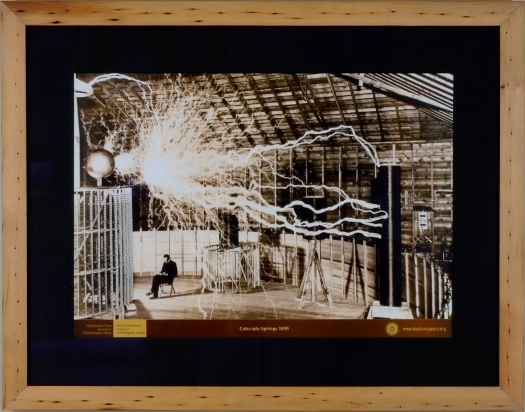
Publicity photo of Nikola Tesla sitting in his laboratory in Colorado Springs in December 1899
Frame as a Statement
The primary purpose of picture framing is to show artwork well. Frames could also be masterpieces, standalone works of art, but it is possible with the combination of beauty and an idea to bring custom framing to a new higher level. The unity of design elements with a subject could result in creating something special and quite unique. The combination of Tesla, Urban Ashes, and my personal as well as Oliver Brothers’ values could be an educational tool while inspiring conversation and discussion about design consciousness, humanity and the much more careful use of our natural resources. Combining science, art, aesthetics and care for the environment has the potential to convey a powerful message and promote responsible action.
The final product is visually pleasing, but it also acts as a promotion for eco-friendly picture framing and more responsibility for our world. With this example, I would like to inspire others in pursuing many green options increasingly available in the picture framing industry.
Thank You
While working on this project I referred to the frame moulding as the “Tesla Frame.” This beautiful piece of wood was a perfect choice for its simplicity and elegance. The visible marks of its previous life were not erased but rather embraced.
I will be forever grateful for all Mr. Tesla did for our society and for an opportunity to honor him in my own way, through my line of work and expertise. The posters of “The greatest geek who ever lived”[iv] did deserve a very special and thoughtful treatment. Learning about Tesla’s work uplifted and inspired me to apply my skills, experience and knowledge in a more meaningful way and to use a custom picture frame as a statement.
Dear Mr. Tesla, this is my way of saying thank you.
Mira Bishop, Oliver Brothers
* Many thanks to Maria Jerinic- Pravica, PhD. for all her help and encouragement
Notes:
[i] Sean Patrick, Nikola Tesla: Imagination and The Man That Invented the 20th Century (Oculus Publisher: 2013)
[ii] “email”, Michael Pravica, Ph.D., Professor of Physics, University of Nevada, Las Vegas, October 17, 2013
[iii] Jane Alcorn, President of the Tesla Science Center at Wardenclyffe. Quoted in National Geographic. “5 Surprising Facts About Nikola Tesla.” Last modified October 2013. Accessed April 7, 2014. http://news.nationalgeographic.com/news/2013/10/131003-nikola-tesla-surprising-facts-statue-museum-science/
[iv] The Oatmeal. “The Greatest Geek Who Ever Lived.” Last modified 2013. Accessed April 2, 2014. http://theoatmeal.com/comics/tesla